Il Cammino dell'Adriatico - Pilgrims on the Italian Adriatic coast
For all pilgrims among you we have good news! There will soon be a new pilgrimage route through Italy, which winds its way directly along the Adriatic coast. Appropriately enough, it also bears the obvious name "Il Cammino dell'Adriatico", i.e. pilgrimage route along the Adriatic coast. The nice thing about it is that for this purpose the old railway embankment is being extended and transformed into a hiking and cycling path. It is not just a pilgrimage route, for which a few signs have been added, but a completely new one, which allows you to avoid the extreme gradients of this region and the unattractive main roads. At the moment this is unfortunately only partially working, but we could see during our hike that the construction workers are already hard at work. Soon nothing will stand in the way of unhindered hiking and cycling.
Mascot of the new hiking trail
We ourselves came across this path by chance. Or rather, the path came upon us. In fact, since Venice, we have been walking along the Adriatic coast almost permanently. Only without a firmly planned path. But today we met three hikers who were equipped with maps, cameras, flyers and all kinds of other things. They approached us and told us that they were collecting material for a PR campaign for this new trail. The piece that is currently being built covers the entire coast of Abruzzo. So it starts in the north at the border with Marche and ends in the south at the border with Molise. The three of them had walked these 130km or so last week and now wanted to report on it in order to attract more pilgrims. So we were just in time and before we knew it, we gave another interview in a language we didn't know. This made us a kind of mascot for the new path, which was now even tested by long-distance travellers before its official opening.
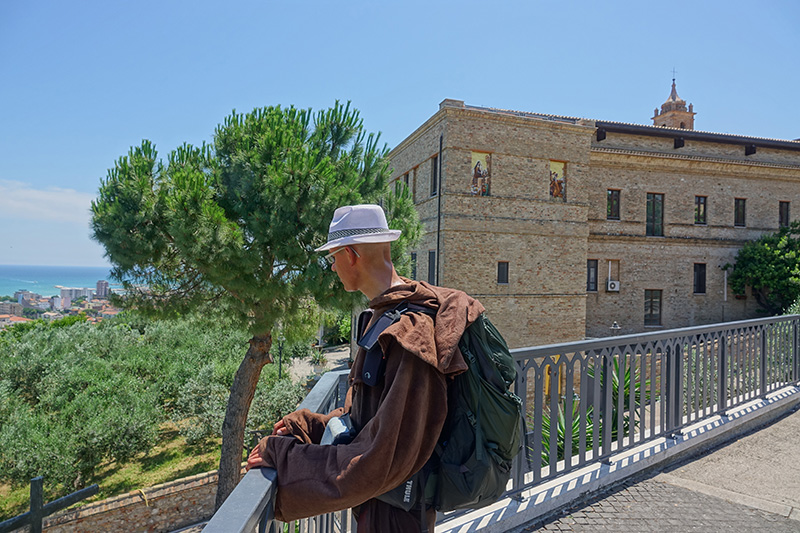
Franz Bujor at the Capuchin monastery
The history of the Adriatic Pilgrimage Route
According to our pilgrimage trail preparers, the course of the trail goes back to a story about three priests. These once came from the north, possibly even from Germany, and migrated south towards Puglia. So for a long time they had the same plan as we have now. However, later they wanted to turn off to Greece and then continue their pilgrimage to Israel.
Not far from the place where our little meeting took place, they took a rest and set up their night camp. One of the priests hung his backpack on a small tree so that he wouldn't have to lie in the dirt. During the night, however, a miracle happened, although one that did not particularly please the priest. While he was asleep the little tree had grown into a real, impressive tree. Now his rucksack was hanging in the crown. Only by a daring climbing and fishing action he managed to regain his luggage.
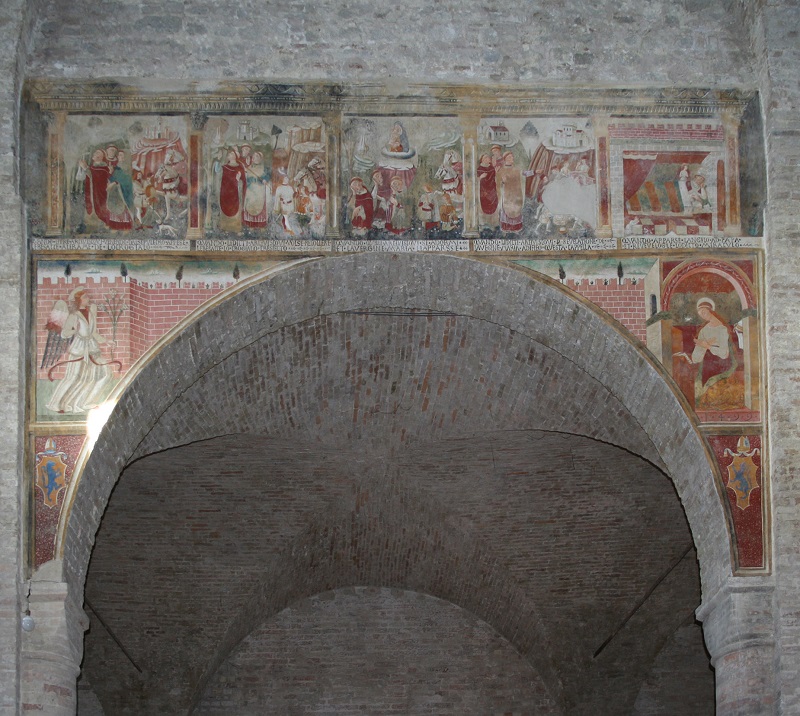
The famous wall painting in the Chiesa di Santa Maria di Propezzano (Those: Di Infinitispazi - Opera propria, Pubblico dominio)
Today there is a church on the same site called Santa Maria di Propezzano. Inside there are some frescoes that tell the story of the three priests and the tree. They are considered to be the oldest records of the use of the route as a pilgrimage route to Israel.
Culture and sights along the way
The pilgrimage route itself did not only pass through Abruzzo, but along the entire Italian Adriatic coast. But it would certainly take years until everything was completed. The 130km that have now been rebuilt, however, also offered a lot of sights and attractiveness on their own. First of all you have to add the sea with its many sandy beaches. Because the nice thing about the pilgrim's path is that thanks to it, you can not only see all the mass beaches but also the small, lonely, idyllic ones.
But those who are not so much after sizzling but rather after sightseeing will find their luck on the other side of the path. Because here there is a new sanctuary, a new monastery or another cultural asset every few kilometres. Excitingly, we had already visited many of these sights in the last days.
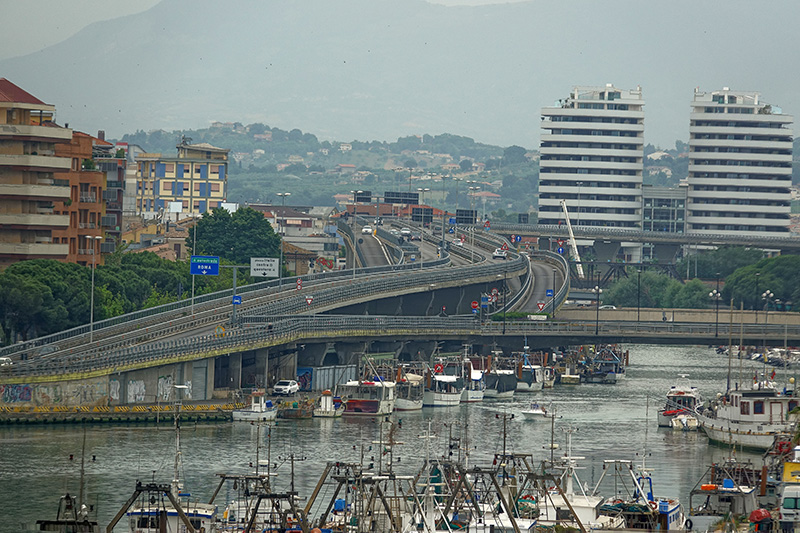
Pescara Port
Santuario Maria Santissima dello Splendore
This is an old Capuchin monastery, which was largely destroyed during the earthquake of 2016/2017. Only the newly built part has survived undamaged and now, due to the old, half-decayed buildings in the background, it looks even more imposing than it actually is. The colourful frescos in the entrance area and the view from the forecourt over the city and the sea are especially beautiful. What impressed us the most was the Way of the Cross that leads down from the centre of the village steeply up the hill up to the convent doors. Even without a cross, one has a good idea of how exhausting this last way must have been for Jesus. The individual stations are represented by beautifully worked out and impressively large bronze statues.
Unfortunately, the monks themselves were a bit unstable, but after some persuasion they accepted us anyway. However, we did not stay overnight in the monastery itself, but in an abandoned conference room above the church, which still belonged to the old buildings. But it was not in danger of collapsing, don't worry. You can find more information here: http://www.madonnadellosplendore.it/
Abbazia di Santa Maria di Propezzano (Motto d‘Oro)
This is the church, with the fresco of the three priests and their tree problem. Since we did not visit it ourselves, we unfortunately cannot say too much about it. Except that today it is a Benedictine abbey. Here you can find the website: www.valledelleabbazie.it
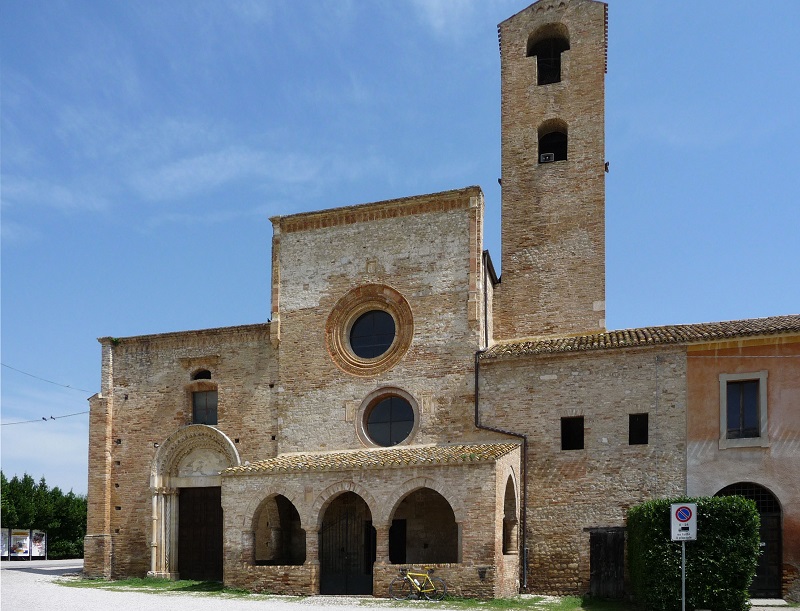
Chiesa di Santa Maria di Propezzano (Quelle: Di Infinitispazi - Opera propria, Pubblico dominio)
Basilica della Madonna die Sette Dolori (Pescara)
In Pescara we stayed in a Franciscan monastery. It was a huge complex and was largely inhabited by very old, friendly and demented friars to whom we told our story over and over again. It was hard to witness, because many of them were still so well together that one would never have suspected that they might be missing something. But it was also a little bit cute how much they were happy every time they had a visitor they didn't know yet.
As our monastery was located directly on the beach and we were not too motivated for long explorations in the heat, I cannot tell you anything about the basilica. But the sea at this place is great, we tested that!
But here you can also find more information about the church: www.settedolori.pe.it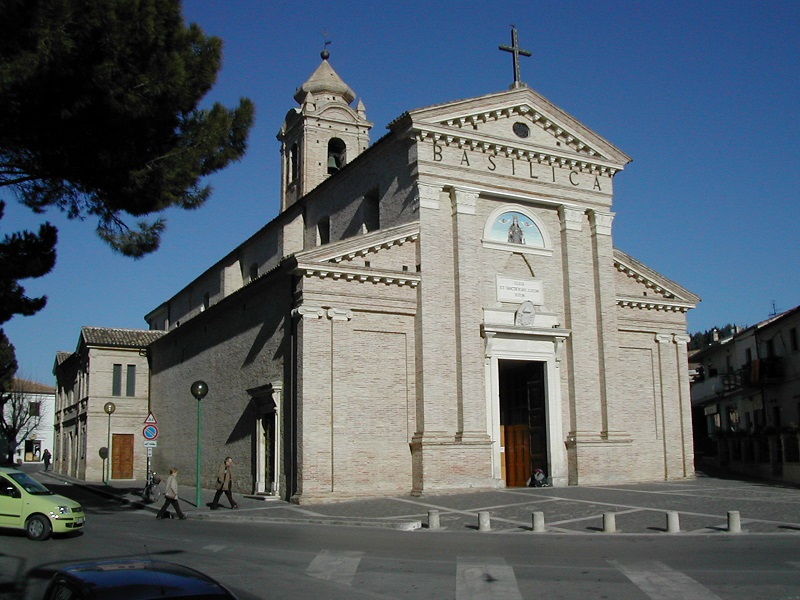
Basilica dei Sette Dolori in Pescara (Quelle: Wikipedia, CC BY-SA 2.5)
Santuario del Miracolo Eucaristico di Lanciano
This sanctuary, in turn, we looked at. But it is not the most exciting one we have ever seen. The story behind it is interesting and mysterious, which is why we have dedicated another article to it. But there is not really much to look at. Also the city of Lanciano itself offers only little worth seeing compared to many others in the surrounding area.
We were allowed to spend the night here in a convent of Brazilian nuns. This again is recommendable, because they are incredibly friendly and warm women whose hospitality outshines that of their Italian brothers and sisters to such an extent that you can hardly recognize them.
And here directly to their website: www.miracoloeucaristico.eu
Abbazia di San Giovanni in Venere (Fossocesia)
We cannot say much about this abbey either. Only that the local monks were almost lynched for their strict refusal to help us. Because despite the recommendation of several priests and brothers from the area, they were not willing to lift a finger to take us in. Since they were not the first to act in this way, but just another community in a whole series of monks and priests who had somehow forgotten their basic principles, we were almost not really upset about it. At this point, I would like to briefly point out the irony that it was precisely the demented monks who could not remember a conversation that took place a minute and a half ago who did not forget these principles!
In any case, we were looking for an alternative due to the cancellation in the nearby town. Unfortunately, it didn't look better here at first, because the local pastor had gone to the holiday camp with a group of students. So I asked for help in a bar. After all it was possible that someone had his mobile phone number. We were immediately advised to go and see the monks, as everyone was sure that they would accommodate us. When we told them about the cancellation, the mood changed. Suddenly everyone was angry with the monks and wanted to confront them. Shortly afterwards, they learned that the local nuns did not want to help us either. Now, at the latest, everyone was hanging on the phone and was putting pressure. Within half an hour, the population had their clergymen ready and we had a complete community center at our disposal.
Here is the website of the abbey: www.sangiovanninvenere.it

Abbazia di San Giovanni in Venere at Fossacesia (source: Wikipedia: Di Zitumassin - Opera propria, Pubblico dominio)
Santuario della Madonna die Miracoli di Casalbordino
The miracles alluded to in the part of the name Miracoli (No it is not a church named after a tomato sauce company) date back to the 6th century A.D. For about 100 years there has also been a Benedictine monastery here, where pilgrims are also warmly welcomed. Unfortunately, the old church has been demolished in the meantime and replaced by a newer and, above all, larger one, which is by far not as beautiful. Only one altar has been preserved. Nevertheless the monastery is quite impressive due to its size. But frankly, it was the garden that we liked most. This was mainly due to the rich offer of fresh and extremely juicy fruits, which after our ascent to the hill seemed like a redemption.
Chiesa della Madonna della Penna (Vasto)
Also on this church we could only have a fleeting glance in passing. Because today was one of the hottest days of the year and the sweat ran off our foreheads to such an extent that we could only look through a waterfall onto the street. I felt like a snowman who had somehow ended up in the Caribbean.
We had been invited to spend the night at the Saliziani Institute, the order that takes care of almost the entire work with children and young people in Italy. Since it is summer vacation here, there are about 300 students here today, who receive a comprehensive animation program from more than 70 volunteer youth workers. Someone else say that youth work is not lucrative! Because they Saliziani belong to the richest orders of the Catholic Church. When you consider that 300 children are now being looked after here for three weeks, whose parents all pay for admission, while the carers are basically volunteers, it makes sense. It is not that they do not do a good job and that they are not allowed to do so. I just want to say that it is quite possible to get rich here by supporting young people.
But if you also want to know something about the famous church, you can find their website here: www.vastospa.it

Santa Maria di Punta Penna in Vasto (source: Wikipedia: Di Zitumassin - Opera propria, CC BY-SA 3.0)
Conclusion on the pilgrim path "Il Cammino dell'Adriatico"
All in all, the Cammino dell'Adriatico is a highly recommendable long distance hiking or pilgrimage route, which combines the advantages of the coast with those of the hilly interior and which is a good alternative or complement to the well-known Way of St. James.
More information about the path and its history can be found here: www.paliurus.it The slogan of the day: Many roads lead to Rome, but not all of them. Stage 1: Storeroom in the Santuario della Madonna dello Splendore, Guilanova, Italy Stage 2: Rectory, Roseto degli Abruzzi, Italy Stage 3: Rectory, Pineto, Italy Stage 4: Hotel run by nuns, Silvi, Italy Stage 5: Franciscan monastery of "San Antonio", Pescara, Italy Stage 6: Rectory, Francavilla al Mare, Italy Stage 7: Indian community, Ortona, Italy Stage 8: Vacant rectory, Frisa, Italy Stage 9: Nunnery, Lanciano, Italy Stage 10: Rectory, Fossacesia, Italy




